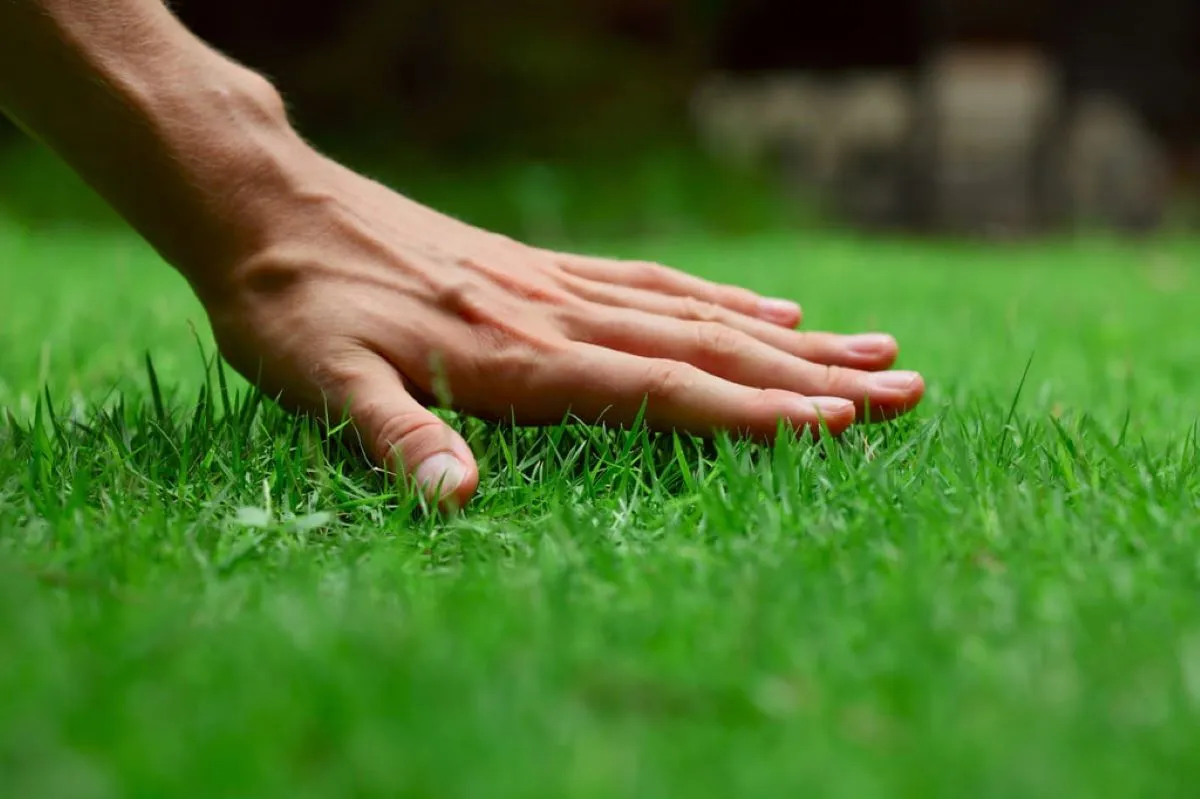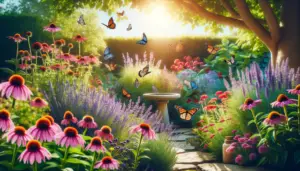Welcome to “Bermuda Grass 101” – our comprehensive guide to understanding and caring for this robust warm-season turfgrass. Known scientifically as Cynodon dactylon, Bermuda grass is renowned for its resilience, adaptability, and aggressive growth. It is preferred for lawns, golf courses, sports fields, and pastures in warm climates.
Understanding the basics of Bermuda grass will help you make informed decisions regarding its use, care, and maintenance. Consider factors such as your climate, intended use, and desired level of supervision when selecting Bermuda grass for your landscape or lawn.
Benefits of Bermuda Grass
Bermuda grass is a popular warm-season grass known for its durability, drought tolerance, and low maintenance. It’s an excellent choice for regions with hot summers, providing a lush and green lawn without too much effort. Bermuda grass’s critical benefits include its ability to tolerate drought conditions thanks to its deep roots, low maintenance requirements, and resistance to weed growth due to its dense growth pattern.
Bermuda grass is an excellent choice for a low-maintenance, drought-tolerant, and weed-resistant lawn. With proper care, Bermuda grass can provide you with a lush and green lawn for years.
Interesting in learning more? Here’s an article we think you’ll like: Benefits of Planting Bermuda Grass in Your Lawn

Caring For Bermuda Grass
Bermuda grass is a popular warm-season grass that is known for its durability and ability to withstand hot temperatures. Proper care and maintenance are essential to keep your Bermuda grass lawn healthy and attractive. Here is a quick summary of Bermuda grass care:
- Mowing: Bermuda grass should be mowed regularly, especially during its active growth period. Set your mower to a height of around 1 to 1.5 inches for a well-maintained lawn. Avoid cutting off more than one-third of the grass height in a single mowing session to prevent stress on the grass.
- Watering: Bermuda grass is drought-tolerant and requires less water compared to other grass types. Deep watering is recommended to encourage deep root growth. Water the lawn thoroughly but infrequently, providing about 1 inch of water per week, including rainfall. Watering in the early morning helps minimize evaporation.
- Fertilizing: Apply a balanced fertilizer to your Bermuda grass lawn during its active growth phase, typically in late spring or early summer. Follow the instructions on the fertilizer package for proper application rates. Avoid over-fertilizing, as it can lead to thatch buildup and weak grass growth.
- Weed Control: Bermuda grass has good weed competitiveness, but occasional weed outbreaks may occur. Use pre-emergent herbicides in early spring to prevent weed seeds from germinating. Spot-treat any existing weeds with a post-emergent herbicide that is safe for Bermuda grass.
- Overseeding and Aeration: If your Bermuda grass lawn has thin areas or experiences winter dormancy, you can consider overseeding with cool-season grasses in the fall. Aeration, which involves creating small holes in the soil, helps improve air and water circulation, reducing thatch buildup and promoting root growth.
- Pest and Disease Management: Bermuda grass is relatively resistant to pests and diseases, but certain issues like grubs, armyworms, and brown patch fungus can still occur. Monitor your lawn regularly for signs of damage and apply appropriate treatments if necessary. Regular mowing and proper lawn care practices help prevent many pest and disease problems.
Remember, specific care practices may vary based on your location, climate, and local conditions. It’s always a good idea to consult with local lawn care experts or extension offices for personalized advice on Bermuda grass care in your area.
Check out our in-depth guide: Mastering Bermuda Grass Care: Your Complete Guide
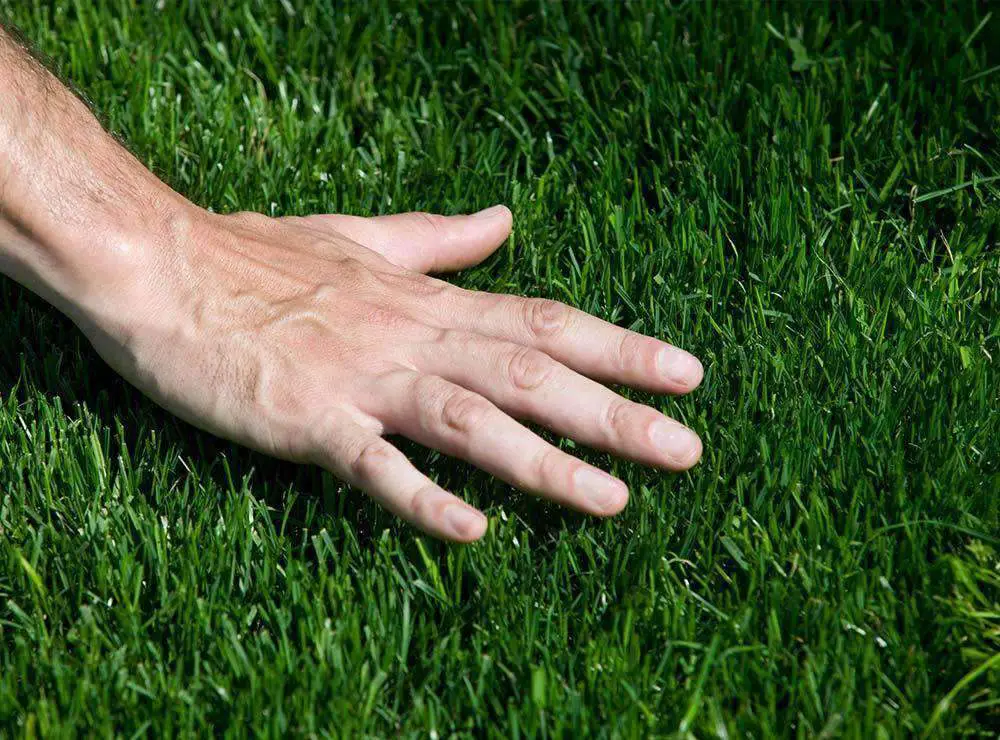
Bermuda Grass Types
Bermuda grass is aperennial grass known for its hardiness and adaptability. Although Bermuda grass is typically treated as a single type of grass, there are several distinct varieties, each with its own characteristics.
Common Bermuda Grass
This is the original variety of Bermuda grass. It’s highly drought-resistant and can grow in a variety of soil types. Common Bermuda grass spreads aggressively and recovers quickly from damage, making it a popular choice for lawns, parks, and sports fields.
Hybrid Bermuda Grass
These are typically crosses between common Bermuda grass and other species in the Bermuda grass family. Hybrids are often denser and greener than common Bermuda grass and have a finer texture. Notable hybrids include Tifway 419, often used on golf courses and sports fields for its durability and attractive appearance, and TifTuf, known for its exceptional drought tolerance.
Improved Common Bermuda Grass
Varieties like ‘Sahara’ and ‘Princess 77’ are genetically improved versions of common Bermuda grass. They offer a darker green color, improved texture, and better resistance to pests and disease compared to the original common Bermuda grass.
Seeded Bermuda Grass
Some Bermuda grass varieties, like ‘Riviera’ and ‘Yukon’, have been developed to be grown from seed, offering a more economical way to establish a Bermuda grass lawn compared to laying sod.
In short, while there is one species known as Bermuda grass, there are multiple varieties, each with unique characteristics. The choice between them depends on your specific needs and environmental conditions, such as soil type, sunlight, traffic levels, and maintenance preferences.
Check out our complete guide here: Bermuda Grass Types: A Guide to Choosing the Perfect Turf
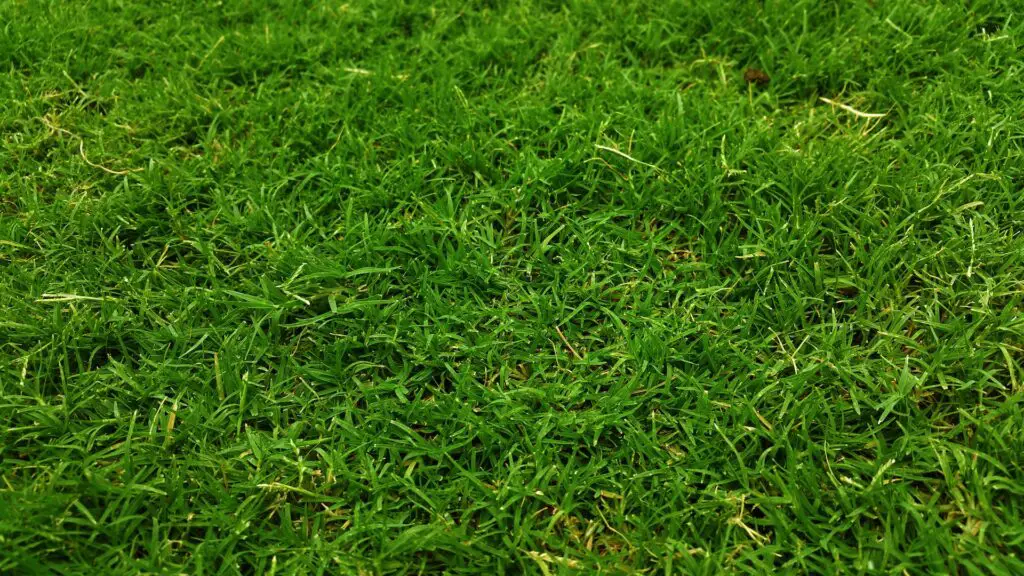
Is Bermuda Grass a Weed?
Depending on its context, Bermuda grass is often viewed differently. It is considered both a valuable turf grass and a persistent weed.
As a turf grass, Bermuda grass is highly appreciated for its aggressive growth, resistance to heat, drought, and wear, making it a popular choice for lawns, golf courses, and sports fields in warm climates. It’s also widely used for erosion control and livestock grazing due to its high yield and resilience.
On the other hand, Bermuda grass is often seen as a weed due to its invasive nature. Its aggressive growth habit, ability to spread via seeds and a complex network of underground stems (rhizomes) and above-ground runners (stolons), and resistance to many standard weed control methods make it a troublesome invader in gardens, landscapes, and agricultural fields. Bermuda grass can quickly overtake and choke out other plants, so it’s often labeled as a weed.
So, whether Bermuda grass is considered a weed is primarily a matter of perspective and depends on its location and the desired use of its land.
Still curious? Click here to read our full blog that answers the question, “Is Bermuda Grass a Weed?“

How To Get Rid of Bermuda Grass
Getting rid of Bermuda grass can be challenging due to its aggressive growth habit, but it is not impossible. The process involves a combination of manual removal, herbicides, and cultural practices.
Manual Removal
Bermuda grass can be manually removed by digging out the grass and its roots. This method is most effective for small infestations. However, care must be taken to remove all root fragments, as even small pieces left in the soil can regrow.
Herbicides
Post-emergent glyphosate-based herbicides can be effective in killing Bermuda grass. It’s best applied when the grass is actively growing. Multiple applications may be necessary as Bermuda grass is resilient and can recover from a single application.
Solarization
This method covers the area with clear plastic during the hottest months of the year, trapping solar heat to kill the grass and its roots.
Smothering
Covering the grass with heavy newspaper, cardboard, or landscape fabric layers can help kill Bermuda grass over time. This blocks sunlight and suffocates the grass.
Maintain a Healthy Lawn
Keeping your lawn healthy, thick, and well-watered can help prevent Bermuda grass invasion. Regular mowing, watering, and fertilization help the desired grass outcompete Bermuda grass.
Pre-emergent Herbicides
These can prevent Bermuda grass seeds from germinating. However, they will not kill existing plants.
Due to its highly resilient and aggressive nature, these methods will likely need to be repeated to eradicate Bermuda grass. It’s also important to note that some procedures, such as using herbicides, should be used cautiously to avoid damage to non-target plants and the environment.
Looking for more? Check out our complete guide here: How To Get Rid of Bermuda Grass

How To Get Bermuda Grass To Spread
If you aim for a lawn filled with Bermuda grass, you can achieve its spread through proper maintenance, watering, and fertilization.
Regular Mowing
Bermuda grass thrives when mowed frequently to a height of 1 to 1.5 inches. This encourages the grass to grow outward (lateral growth) instead of upward, promoting a dense, carpet-like lawn.
Adequate Watering
Bermuda grass needs at least 1 inch of water per week. During hot, dry periods, this may need to be increased. Overwatering should be avoided, as it can encourage fungal diseases.
Fertilization
Bermuda grass requires a high amount of nitrogen for optimum growth. Fertilizers should be applied during the growing season, generally in late spring and early summer. A soil test can provide specific fertilizer recommendations.
Aeration
Aerating the soil in the spring can help alleviate soil compaction, improve water and nutrient uptake, and promote the spread of Bermuda grass.
Dethatching
Bermuda grass produces a layer of thatch – a layer of dead grass and roots – that can prevent water and nutrients from reaching the soil. Dethatching helps remove this layer, promoting better grass growth and spread.
Overseeding
If there are bare patches, overseeding can help promote a dense lawn. This involves spreading grass seeds over the existing property during the growing season. Keep the area well-watered until the new grass germinates and establishes.
Bermuda grass spreads naturally via its extensive network of stolons (above-ground runners) and rhizomes (below-ground stems). These practices should stimulate the grass to maximize its natural spreading capabilities.
Check out our complete guide here: How To Get Bermuda Grass To Spread
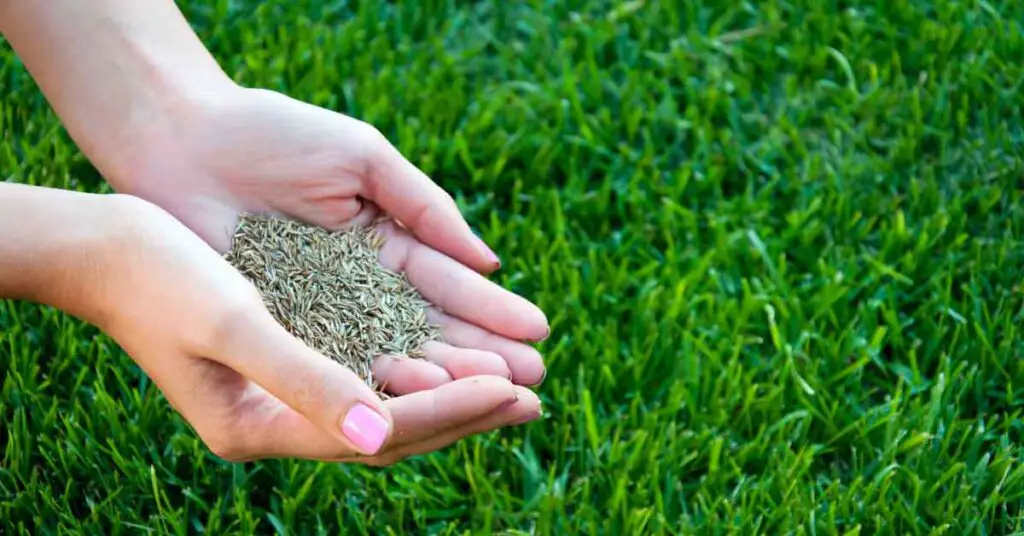
How to Plant Bermuda Grass From Seed
Step 1: Soil Preparation
Before sowing Bermuda grass seeds, it’s essential to prepare the soil. Remove any existing grass or weeds and till the soil to a depth of about 6 inches. For optimal results, amend the soil with compost or a slow-release fertilizer to improve nutrient content. After tilling and amending, rake the soil to create a smooth and level surface.
Step 2: Sowing the Seeds
Bermuda grass seeds are quite small, so they should be sown evenly across the surface of the soil. The general recommendation is to use about 1 to 2 pounds of seeds per 1000 square feet. Using a broadcast spreader can help distribute the seeds uniformly.
Step 3: Lightly Cover and Water
After sowing, lightly rake the seeds into the top 1/8 inch of the soil. Following that, a gentle watering is necessary. The goal is to keep the top layer of soil consistently moist until the seeds germinate, which usually takes about 5 to 10 days. Overwatering can cause the seeds to wash away, so use a gentle spray or mist.
Step 4: Maintenance
Once the grass sprouts, reduce watering frequency but increase the amount of water each time to encourage deeper root growth. Mowing can begin when the grass reaches about 2 inches in height. Regular fertilization every 6 to 8 weeks during the growing season will support healthy growth.
In conclusion, planting Bermuda grass from seed involves careful soil preparation, precise sowing, and diligent maintenance. With patience and the right care, Bermuda grass can create a robust, attractive lawn that’s resistant to heat and heavy foot traffic.
Check out our ultimate guide here: How to Plant Bermuda Grass from Seed: The Green Thumb Guide

How Short to Cut Bermuda Grass
Bermuda grass thrives when mowed short. The ideal height for Bermuda grass is typically between 1.5 to 2 inches in length. This height promotes denser growth, which gives the lawn a lush and full appearance.
However, the recommended height can slightly vary depending on the specific type of Bermuda grass and the lawn’s usage. For instance, common Bermuda grass can be mowed to about 1.5 to 2.5 inches, while hybrid varieties, like Tifway 419, can be cut shorter, around 0.5 to 1.5 inches, especially on golf courses or sports fields.
In any case, it’s essential not to remove more than one-third of the grass blade length at any one mowing. This practice, often referred to as the “one-third rule,” helps to maintain a healthy lawn and prevent stress on the grass.
In terms of frequency, during the peak growing season (late spring and summer), Bermuda grass might require mowing as often as twice a week. In cooler months or periods of drought, mowing frequency can be reduced as the grass growth slows down.
In summary, maintaining the right mowing height for Bermuda grass is crucial for a healthy, attractive lawn. This involves keeping the grass relatively short, abiding by the “one-third rule,” and adjusting the mowing frequency according to the growing season.
Check out our ultimate guide here: How Short to Cut Bermuda Grass: The Ultimate Guide to Achieving a Lush and Healthy Lawn

How Much Sun Does Bermuda Grass Need?
Bermuda grass thrives in full sun. It typically needs about six to eight hours of direct sunlight each day for optimal growth. The more sunlight Bermuda grass receives, the better it grows, making it an excellent choice for open landscapes with little to no shade.
Its high sunlight requirement is one of the reasons why Bermuda grass is so popular in the southern United States, where the climate is typically sunny and warm. However, this also means Bermuda grass is not the best option for lawns with significant shade as it doesn’t perform well in low light conditions.
In the absence of adequate sunlight, Bermuda grass may become thin and patchy, and its aggressive growth can slow down considerably. In shaded areas, it might be more appropriate to choose a shade-tolerant grass variety.
In short, Bermuda grass is a sun-loving grass. It thrives in full sunlight, requiring at least six to eight hours of direct sun per day for healthy, vigorous growth. If your lawn gets less sun, you might want to consider other grass types that are more shade-tolerant.
Check out our complete guide here: How Much Sun Does Bermuda Grass Need?

Fertilizing Bermuda Grass
Bermuda grass responds well to high-quality fertilization. Proper fertilization encourages a lush, thick lawn and helps the grass resist pests and diseases.
For Bermuda grass, it’s ideal to use a complete nitrogen-phosphorous-potassium (N-P-K) fertilizer with a ratio like 3-1-2 or 4-1-2. The exact amount of fertilizer required depends on your soil type and its nutrient content, which can be determined by a soil test.
As a general rule, Bermuda grass benefits from about 1 pound of nitrogen per 1,000 square feet per month during the growing season, typically from late spring through early fall. Fertilize once in early spring after the last frost, then every 4 to 6 weeks during the active growing period until early fall. Avoid fertilizing late in the season as this can make the grass more susceptible to winter damage.
Apply the fertilizer evenly using a spreader, then water the lawn thoroughly to help the nutrients penetrate the soil and reach the grass roots.
Remember, over-fertilization can lead to thatch buildup and increased susceptibility to pests and diseases, so it’s crucial not to overdo it. Always follow the manufacturer’s instructions on the fertilizer package.
In summary, fertilizing Bermuda grass involves using a complete N-P-K fertilizer, applying it every 4 to 6 weeks during the growing season, and watering thoroughly after application. A soil test can provide a more precise fertilization plan tailored to your lawn’s needs. As always, careful application is crucial to prevent problems associated with over-fertilization.
Check out our ultimate guide: Fertilizing Bermuda Grass
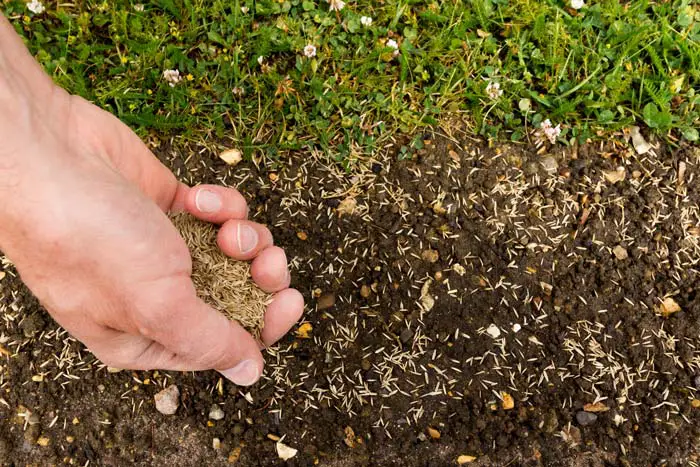
When to Plant Bermuda Grass
Bermuda grass thrives in hot temperatures and grows most vigorously during the late spring and summer months. Therefore, the best time to plant Bermuda grass seed or lay Bermuda grass sod is during late spring or early summer when soil temperatures consistently stay above 65°F (18°C). This is typically when daytime temperatures are in the 80s (around 27-32°C), ensuring optimal germination and establishment.
Planting Bermuda grass during this period allows it to develop a strong root system and reach a healthy size before cooler weather in the fall slows its growth. However, it’s also essential to make sure there’s no risk of a late spring frost after planting, as this could damage or kill young Bermuda grass.
If you’re overseeding an existing Bermuda grass lawn, you’ll also want to do this in late spring or early summer. The warm-season Bermuda grass will grow and fill in as the cool-season grass, which may have been planted for winter color, begins to fade with the rising temperatures.
In short, late spring or early summer is the optimal time to plant Bermuda grass. This warm-season grass needs ample sunlight and heat to grow robustly and establish itself before cooler weather arrives. As always, adjusting the timing based on local climate and weather patterns is key.
Check out our complete guide here: When to Plant Bermuda Grass: The Ultimate Guide to Achieving a Lush Lawn

Bermuda Grass vs. Zoysia Grass
Zoysia and Bermuda are both warm-season grasses that are commonly used for lawns due to their thick growth and resilience to heat.
Zoysia grass is known for its ability to withstand both sunny and shady conditions. It has a slower growth rate than Bermuda grass, but it’s hardy and can endure colder weather a bit better. It has a fine texture and a deep green color, and it requires less frequent mowing due to its slow growth. However, it tends to turn brown during the winter months and can take longer to green up in the spring.
Bermuda grass, on the other hand, loves sun and heat. It’s popular in Southern climates for its ability to withstand high temperatures and drought conditions. Bermuda grass has a rapid growth rate and can quickly recover from damage. This can be a benefit for high-traffic areas but also means it requires frequent mowing to keep it looking tidy. It’s not as shade-tolerant as Zoysia and may struggle in areas with significant tree cover.
Both grasses have their benefits and drawbacks, and the best choice often depends on the specific conditions of your lawn, including sunlight exposure, foot traffic, and maintenance preferences.
Check out our in-depth article here: Zoysia Grass vs. Bermuda: The Ultimate Guide
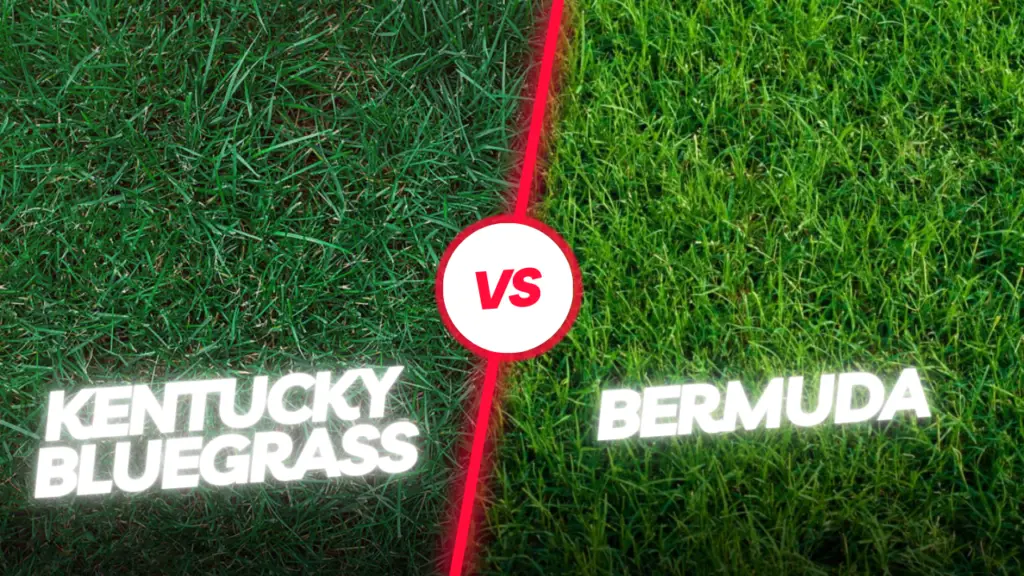
Bermuda Grass vs. Kentucky Bluegrass
Bermuda grass, known scientifically as Cynodon dactylon, is a warm-season perennial grass. This means it thrives in the heat, particularly in southern United States where the climate is warm and sunny. Bermuda grass is drought-tolerant, handles high foot traffic remarkably well, and recovers quickly from damage, making it a preferred choice for sports fields, parks, and lawns. On the flip side, it tends to go dormant in colder weather, turning a less appealing brown color, and can be somewhat invasive due to its aggressive growth pattern.
Kentucky Bluegrass (Poa pratensis), on the other hand, is a cool-season perennial grass. It flourishes in the cooler, northern regions of the United States. Kentucky Bluegrass is lauded for its rich, lush green color, and dense, carpet-like growth which makes it ideal for high-end landscapes and lawns. It requires regular watering and doesn’t handle extreme heat or drought well. Also, it can be a bit slow to establish, but once it does, it creates a robust lawn.
Ultimately, the choice between Bermuda grass and Kentucky Bluegrass comes down to your location’s climate, the intended use of your lawn, and the level of maintenance you’re willing to put in. Bermuda grass is the hardier option, demanding less maintenance and handling heat well, perfect for the South. Kentucky Bluegrass, while requiring more care and water, offers a luxurious green carpet, ideal for cooler, Northern climates.
Want to learn more? Check out our complete guide here: Bermuda Grass vs. Kentucky Bluegrass
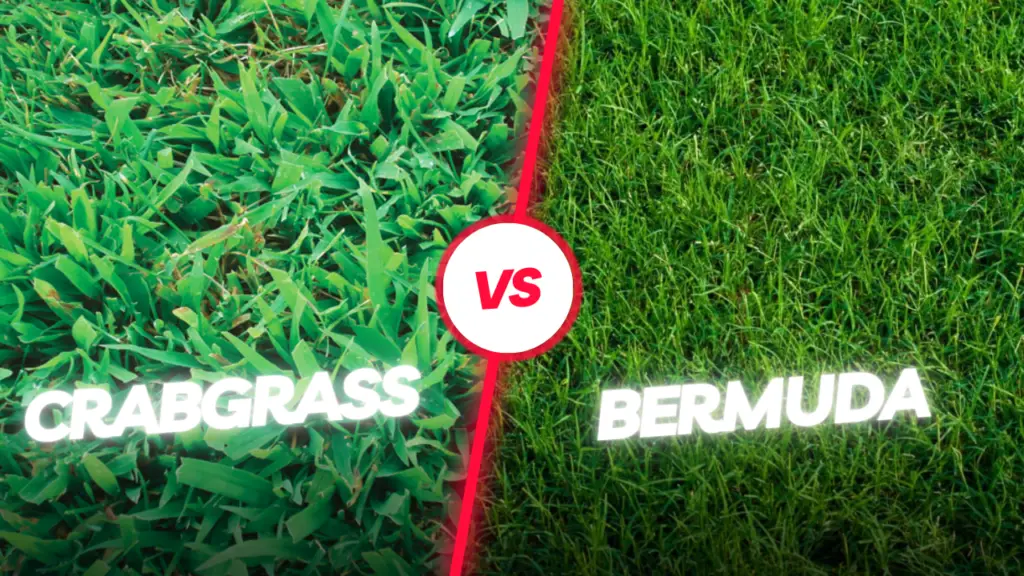
Bermuda Grass vs. Crabgrass
Crabgrass, also known as Digitaria, is an annual warm-season grass. It’s often classified as a weed, primarily due to its invasive growth habit. It’s a highly resilient grass, able to survive in poor soil conditions and withstand high heat and drought. Its distinct characteristic is the spreading low-to-the-ground pattern, with leaves folding along the midrib, and its seedheads resemble a crab’s legs, hence the name. However, it’s generally considered undesirable because of its coarse texture and patchy appearance.
Bermuda grass, scientifically known as Cynodon dactylon, is a warm-season perennial grass. It thrives in full sunlight and high temperatures, common in the southern United States. Bermuda grass is favored for its tolerance to drought, resistance to heavy foot traffic, and fast recovery rate. However, it can also be invasive due to its aggressive growth, but unlike Crabgrass, it’s often cultivated intentionally for lawns, sports fields, and golf courses because of its fine texture and appealing green color.
In essence, Bermuda grass and Crabgrass both thrive in warm conditions and are highly resilient. However, Bermuda grass is generally the more desirable choice for intentional lawn cultivation due to its appearance and texture, while Crabgrass is often viewed as a nuisance weed that disrupts the uniformity of lawns. Your choice between the two will depend on your lawn’s purpose, the climate, and your tolerance for weeds.
Still curious? Check out our complete guide here: Bermuda Grass vs. Crabgrass

Bermuda Grass vs. Centipede Grass
Bermuda grass (Cynodon dactylon) is a warm-season perennial grass that loves heat and sunlight. It’s widely appreciated for its resilience to drought and ability to withstand heavy foot traffic, making it a perfect choice for sports fields and high-traffic lawns in the southern United States. Bermuda grass has a fast growth rate and quick recovery from damage, although this can also lead to its invasive spread if not properly managed. In cooler weather or the winter season, Bermuda grass goes dormant, turning brown until temperatures rise again. It demands regular maintenance, including frequent mowing and fertilization, to retain its appealing look.
Centipede grass (Eremochloa ophiuroides), another warm-season grass, is typically suited for Southeastern United States with its moderate climate. It’s well-known for its low maintenance requirements. Centipede grass grows slowly and doesn’t require frequent mowing, a stark contrast to the fast-growing Bermuda grass. It does well in acidic soils, and while it doesn’t need as much fertilization as Bermuda grass, it can be sensitive to overly fertile conditions. Its tolerance to foot traffic and drought isn’t as high as Bermuda grass, but its adaptability and low maintenance make it a favorite for home lawns.
In conclusion, while both grasses are suited for warmer climates, Bermuda grass is more robust and better equipped for high traffic but needs more care. In contrast, Centipede grass is more about ease of maintenance and slower growth, but it can’t handle as much wear and tear.
Want to learn more? Check out our full guide here: Bermuda Grass vs. Centipede Grass

Bermuda Grass vs. Fescue
Bermuda grass, scientifically named Cynodon dactylon, is a warm-season perennial grass known for its toughness and resilience. Thriving in hot and sunny climates like the southern United States, Bermuda grass is drought-resistant and can handle heavy foot traffic, making it an ideal choice for lawns, sports fields, and golf courses. It’s characterized by its aggressive growth and rapid recovery from damage. However, this also means it can be somewhat invasive if not well-managed. Bermuda grass does require regular maintenance including mowing and fertilization, and it tends to go dormant, turning brown in cooler weather or in winter.
On the flip side, Centipede grass (Eremochloa ophiuroides) is another warm-season grass, typically found in the Southeastern United States with its mild winters and moderate summers. What sets Centipede grass apart is its low maintenance requirements. It grows slower than Bermuda grass and doesn’t need frequent mowing. Additionally, Centipede grass does well in acidic soils, and while it requires less fertilization than Bermuda grass, it can be sensitive to overly fertile conditions. It’s not as tolerant of foot traffic or as drought-resistant as Bermuda grass, but its adaptability and low maintenance make it a popular choice for home lawns.
In essence, your decision between Bermuda grass and Centipede grass would depend on your specific needs and conditions. Bermuda grass is tougher and can withstand more wear and tear, but requires more maintenance. Centipede grass, on the other hand, offers ease of care and slower growth, but isn’t quite as resilient to traffic and drought.
Check out our full guide here: Bermuda Grass vs. Fescue
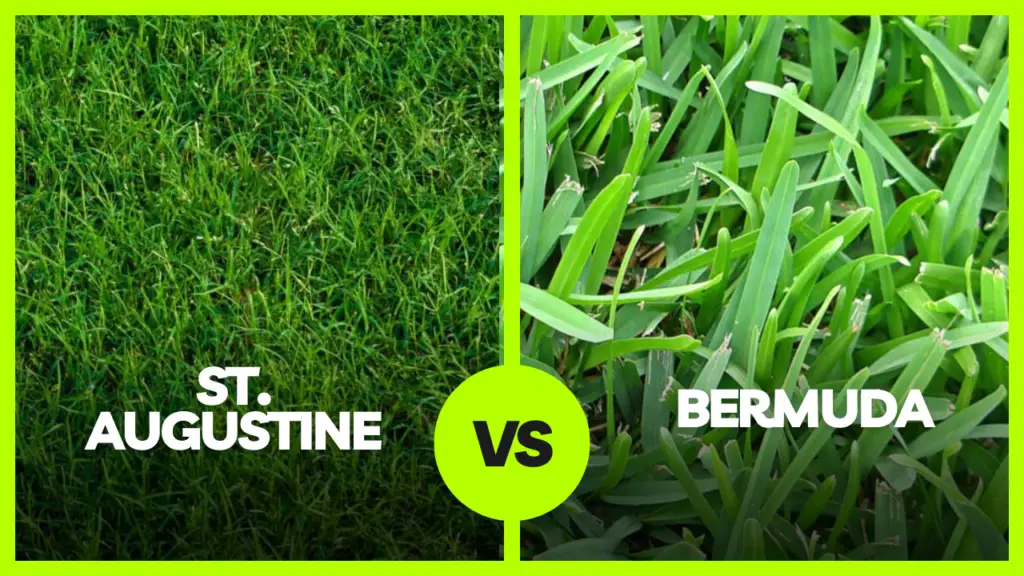
Bermuda Grass vs. St. Augustine Grass
Bermuda grass (Cynodon dactylon) is a robust, warm-season perennial grass, widely preferred in hot, sunny climates like the southern United States. It’s especially recognized for its tolerance to drought and resilience to heavy foot traffic, making it an ideal choice for parks, sports fields, and lawns. Bermuda grass displays aggressive growth and recovers quickly from damage, although this can also lead to invasive spread if not properly managed. During cooler weather or winter, Bermuda grass goes dormant, turning brown. It requires regular maintenance, including frequent mowing and fertilization, to maintain its attractive appearance.
On the other hand, St. Augustine grass (Stenotaphrum secundatum) is another warm-season grass, but it’s better adapted to coastal areas with mild winter temperatures. It’s appreciated for its ability to grow well in a variety of soil types, and it’s especially good at handling shade, a quality Bermuda grass lacks. St. Augustine grass has broad, flat blades and a dark green color that many homeowners find appealing. However, it requires a fair amount of watering and is not as drought-resistant as Bermuda grass. Furthermore, it doesn’t handle heavy foot traffic as well as Bermuda grass.
To summarize, while both Bermuda grass and St. Augustine grass are suitable for warm climates, the choice between the two depends on specific conditions and needs. Bermuda grass is more durable and drought-resistant but requires more maintenance, while St. Augustine grass thrives in shade and diverse soils but needs regular watering and doesn’t handle heavy foot traffic as well.
Check out our full guide here: Bermuda Grass vs. St. Augustine
